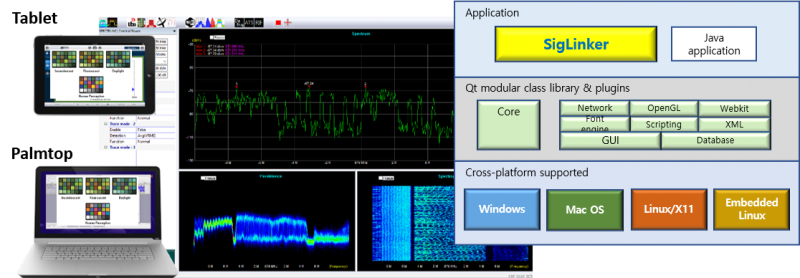Service
Real Time Spectrum Analyzer
The Real-time Spectrum Analyzer Measurement application can use XCR series to convert sampled signal data into signal spectra at a very high rate.
Spectrogram
A Spectrogram is built from a sequence of spectra by stacking them together in time and by compressing the power axis into a ‘contour map’ drawn in various colour scale. The final graph has time along the horizontal axis, frequency along the vertical axis, and the power of the signal at any given time and frequency is shown as various color level.A
Persistence
SigLinker are able to produce much more information for users to examine the frequency spectrum in more detail. A normal swept spectrum analyzer would produce max peak, min peak displays for example but SigLinker is able to plot all calculated FFT’s over a given period of time with the added colour-coding which represents how often a signal appears.
The following figure shows a screen running at the same time the spectrum graph, spectrogram and persistence graph. And the adjacent channel leakage-power ratio (ACLR) test verifies that system transmitters are performing within specified limits.


WLAN
SigLinker offers the measurement and analysis of 802.11 a/b/g, 802.11n and 802.11ac specification. The supported modulation schemes are DSSS(Direct Sequency Spread Spectrum) and OFDM(Orthogonal frequency-division multiplexing) except GMSK.
LTE
Long-Term Evolution (LTE) is a standard for high-speed wireless communication for mobile phones and data terminals. LTE supports scalable carrier bandwidths, from 1.4 MHz to 20 MHz and supports both frequency division duplexing (FDD) and time-division duplexing (TDD). SigLinker supports all analysis of 3GPP TS 36.104 test items
GSM/GPRS/EDGE
GSM (Global System for Mobile Communications) is a standard developed by the European Telecommunications Standards Institute (ETSI) to describe the protocols for second-generation (2G) digital cellular networks used by mobile phones.
Features
- 20 MHz to 6.2 GHz frequency range covers a broad range of analytical needs
+20 dBm to -160 dBm measurement range
Standard GPS/GLONASS receiver
Various demodulation technologies
– WLAN
– LTE
– GSM/GPRS/EDGE
– Bluetooth: Available in December 2016
– WCDMA: Available in November 2016- 10 MHz reference input
Trigger and Sync input
USB 3.0 Micro-B female connector
Application programming interface included for Microsoft Windows environments
